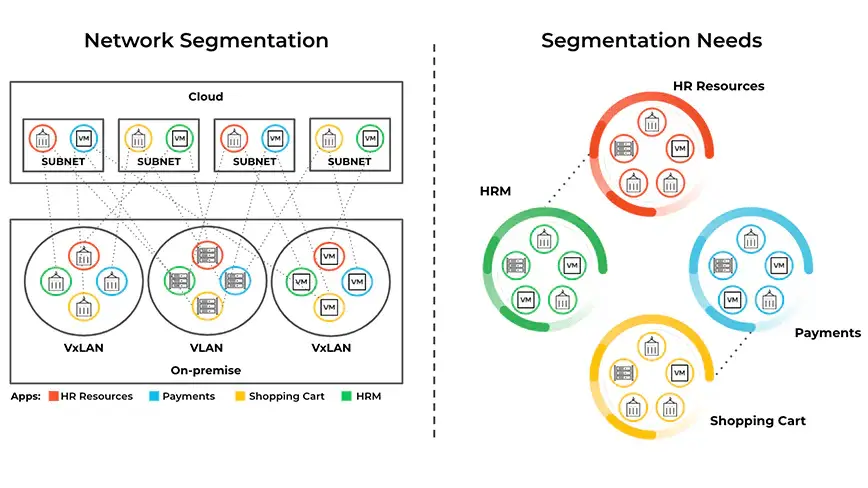Enter microsegmentation, an innovative approach to network security that is revolutionizing the way organizations protect their sensitive data and resources.
In this article, we delve into the world of micro-segmentation, exploring its significance, benefits, challenges, and real-world examples.
Find out how it can potentially reduce costs and explore steps to get started with this advanced security approach.
What is Microsegmentation in Networking & Why Is It Important?
Microsegmentation in networking refers to the practice of dividing a network into smaller, isolated segments, or microsegments, to enhance security and control network traffic.
Unlike traditional network security measures that rely on perimeter defenses, micro-segmentation operates at a granular level within the network, allowing organizations to establish fine-grained access controls and contain potential security breaches.
In today’s digital landscape, where cyber threats are constantly evolving, micro segmentation has become increasingly important. It provides organizations with a proactive security approach that goes beyond the traditional defense-in-depth strategy.
By implementing micro segmentation, organizations can limit the lateral movement of attackers within their network, preventing them from freely accessing sensitive data or systems.
This approach reduces the attack surface, making it significantly harder for cybercriminals to exploit vulnerabilities and carry out successful attacks.
Micro-segmentation also plays a vital role in protecting critical assets and meeting regulatory compliance requirements.
By segmenting the network and applying specific security policies to each segment, organizations can ensure that only authorized individuals or devices have access to sensitive data or resources.
This level of control helps organizations maintain compliance with industry regulations, such as the General Data Protection Regulation (GDPR) or the Health Insurance Portability and Accountability Act (HIPAA).

What Are the Benefits, Challenges, and Examples of Microsegmentation
Microsegmentation offers a range of benefits that significantly enhance an organization’s security posture. Let’s delve into some of the key advantages, as well as the challenges and examples in practice.
- Benefits of Microsegmentation
- Reduced Attack Surface: By dividing the network into smaller segments, each with its own access controls, it limits the potential points of entry for attackers. Even if one segment is compromised, the rest of the network remains secure, reducing the impact of a breach.
- Improved Breach Containment: Allows organizations to isolate compromised segments, preventing lateral movement and minimizing the potential damage caused by an attacker. This containment prevents the spread of malware or unauthorized access to critical systems or data.
- Enhanced Compliance: Enables organizations to apply specific security policies to different network segments, ensuring compliance with regulatory standards and industry-specific requirements. It allows for granular control over data access, privacy, and protection.
- Simplified Security Management: With micro-segmentation, organizations can manage security policies at a segment level, reducing the complexity of network-wide security measures. It enables security teams to focus on individual segments, improving efficiency and reducing the risk of misconfiguration.
- Challenges of Microsegmentation
While micro segmentation offers numerous benefits, implementing and managing it does come with some challenges. These include:
- Complexity: It requires careful planning, design, and ongoing management. It involves defining policies, mapping network traffic, and ensuring compatibility with existing infrastructure. Organizations may face challenges in understanding the intricacies of their network architecture and configuring micros egmentation effectively.
- Traffic Visibility: Segmenting the network can potentially limit visibility into network traffic, making it more challenging to monitor and analyze. Organizations must implement appropriate monitoring tools and strategies to maintain visibility while maintaining the benefits of micro-segmentation.
- Scalability: As networks grow and evolve, scaling microsegmentation can be complex. Organizations need to ensure that their solution can handle increasing network traffic, diverse applications, and emerging technologies.
- Examples of Microsegmentation
Many organizations across various industries have successfully implemented micro segmentation to strengthen their security posture. For example:
- a) Financial Institutions: Banks and financial institutions often utilize micro-segmentation to protect customer data, separate regulatory compliance systems, and secure financial transactions within their network.
- b) Healthcare Providers: Healthcare organizations employ micro segmentation to isolate electronic health records (EHR) systems, protect patient privacy, and restrict access to medical devices, ensuring the integrity and availability of critical healthcare systems.
- c) Cloud Service Providers: Is instrumental in securing cloud environments, enabling cloud service providers to isolate customer workloads, protect against lateral movement, and provide enhanced security controls for their customers.
Will Microsegmentation Reduce Costs?
Microsegmentation is not only a robust security strategy but can also have a positive impact on an organization’s cost efficiency.
Let’s explore how microsegmentation can reduce costs while enhancing network security.
Firstly, microsegmentation improves resource utilization by enabling organizations to allocate their network resources more efficiently.
By segmenting the network, organizations can allocate specific resources, such as bandwidth, processing power, and storage, to each segment based on its unique requirements.
This targeted resource allocation ensures that resources are not wasted on unnecessary or unused segments, leading to cost savings.
Additionally, microsegmentation minimizes the risk of a security breach or data breach, which can result in substantial financial losses.
By implementing granular access controls and isolating sensitive data or critical systems, organizations reduce the potential impact and cost of a breach.
The containment provided by microsegmentation restricts lateral movement and limits an attacker’s ability to move freely within the network, minimizing the potential damage caused by a successful breach.
Furthermore, microsegmentation helps organizations achieve compliance with regulatory standards. Non-compliance can lead to severe financial penalties, legal consequences, and damage to an organization’s reputation.
By implementing microsegmentation and enforcing specific security policies for each segment, organizations can meet the regulatory requirements relevant to their industry. Compliance with these standards avoids costly penalties and ensures that the organization maintains a positive reputation.
While microsegmentation itself may involve upfront costs, such as implementing the necessary infrastructure and deploying appropriate security solutions, the long-term cost savings and risk reduction outweigh the initial investment.
The proactive nature of microsegmentation helps organizations avoid the substantial costs associated with remediation, legal fees, loss of customer trust, and potential fines resulting from a security breach.
How to Get Started with Microsegmentation
Getting started with microsegmentation requires a systematic approach to ensure successful implementation and maximize its benefits.
Here are some essential steps to consider when embarking on a microsegmentation journey:
- Assess your network: Begin by conducting a comprehensive assessment of your network infrastructure, identifying critical assets, data flows, and potential security vulnerabilities. This assessment helps you understand the structure and requirements of your network, laying the foundation for effective microsegmentation planning.
- Define segmentation objectives: Determine your goals and objectives for microsegmentation. Understand the specific security requirements of different network segments, such as isolating sensitive data, protecting critical systems, or ensuring compliance. Clearly define the boundaries and policies for each segment based on these objectives.
- Develop a segmentation plan: Based on your assessment and segmentation objectives, develop a detailed plan for implementing microsegmentation. Consider factors such as segment size, network topology, access control policies, and traffic flow. Collaborate with network and security teams to design a scalable and manageable segmentation architecture.
- Select appropriate security solutions: Choose the right security solutions and tools that align with your microsegmentation strategy. Look for solutions that offer granular access controls, network visibility, and monitoring capabilities specific to microsegmented environments. Consider solutions from reputable vendors like Cisco, who offer comprehensive microsegmentation solutions tailored to various network architectures.
- Implement and test: Deploy the microsegmentation solution according to your plan and test its effectiveness. Ensure that access controls are properly enforced, traffic flows are regulated as intended, and critical assets are adequately protected. Conduct thorough testing and validation to identify any misconfigurations or potential gaps in your microsegmentation implementation.
- Monitor and adapt: Continuously monitor your microsegmented network to detect any anomalies, unauthorized access attempts, or policy violations. Implement robust monitoring tools and establish clear protocols for incident response and remediation. Regularly review and adapt your microsegmentation policies based on changing network requirements, emerging threats, and evolving business needs.
By following these steps, organizations can effectively implement microsegmentation and reap its benefits, including enhanced security, reduced risk, and improved network control.
Additional FAQs
- Q: Is microsegmentation only suitable for large organizations?
A: No, microsegmentation is beneficial for organizations of all sizes. While larger organizations may have more complex network infrastructures, smaller organizations can also benefit from the enhanced security and control offered by microsegmentation.
- Q: Does microsegmentation hinder network performance?
A: When implemented correctly, microsegmentation should not significantly impact network performance. Proper planning, resource allocation, and optimization strategies ensure that network traffic flows efficiently within each segment, minimizing any potential performance degradation.
- Q: Is microsegmentation a one-time implementation?
A: Microsegmentation is an ongoing process that requires continuous monitoring, maintenance, and adaptation. As networks evolve, new applications are introduced, and security threats change, organizations need to regularly review and update their microsegmentation policies to maintain an effective security posture.

